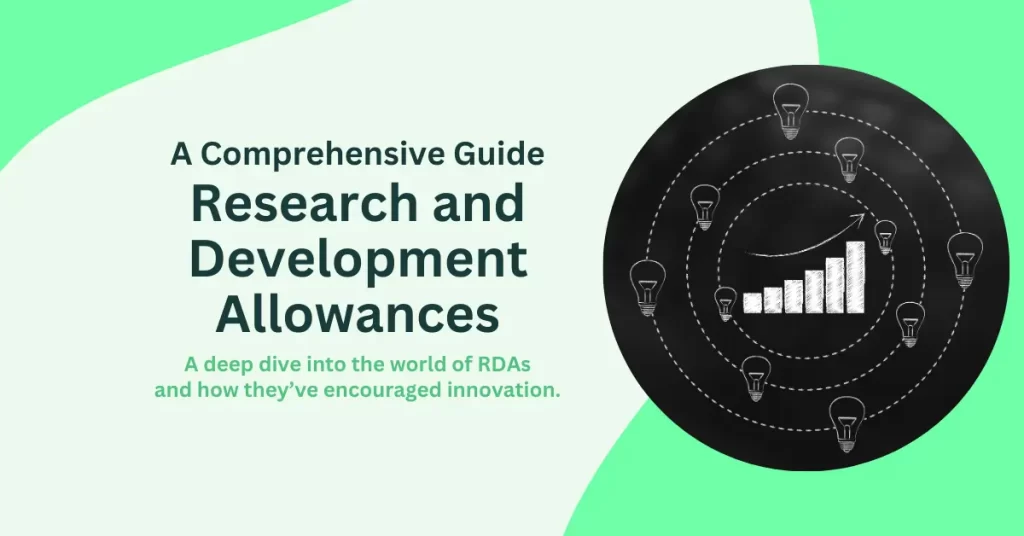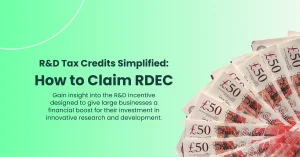Comprehensive Guide to Research and Development Allowances

A deep dive into the world of research and development allowances (RDA). Throughout this article we’ll take a deep dive into the world of RDAs, what makes them different from regular R&D claims, the types of R&D Allowances, the benefits of RDA’s, and how they’ve helped a variety of traders to further expand their research.
There’s no denying that using research and development to advance an industry can become quite costly. In a bid to encourage industry based innovation, Research and Development Allowances (RDAs) offer 100% tax relief on qualifying capital expenditure for businesses involved in R&D activities. RDAs apply to capital costs such as equipment, machinery, and buildings used for R&D purposes, allowing companies to deduct the full amount of their qualifying expenditure from their taxable profits in the year the expense was incurred.
Understanding R&D Capital Allowances
It’s true that R&D capital allowances and RDAs are both tax reliefs that are directed towards investment in innovation, however, they apply to different aspects of R&D spending.
Difference between RDA and Super-Deduction
While the super-deduction provides a 130% tax relief on main rate plant and machinery investments from 1 April 2021 to 31 March 2023, RDAs give 100% tax relief for capital expenditure used directly in R&D activities
Differentiating R&D Capital Allowances from General RDA
R&D capital allowances exist to provide tax relief on capital expenditure in relation to research and development, ensuring that a significant amount of R&D related expenditure can be written off over the course of several years, encouraging companies involved in the initiative to continue their developmental progress.
Meanwhile, general RDAs are reserved for revenue expenditure in research and development. This could include software, staff costs and even subcontracted R&D work. RDA’s allow companies that are implementing research and developmental innovation to deduct up to 100% of their qualifying expenditure.
Types of Research and Development Allowances
There’s a variety of different allowances that incentivise research and development.
Overview of Various R&D Allowances
From the all important tax credits to grants and subsidies, here are some of the resources available to companies throughout their innovation.
- R&D Tax Credits
- RDAs
- Patent Box Regime
- Accelerated Depreciation for R&D Assets
- R&D Specific Grants and Subsidiaries
- Localised R&D Incentives
R&D Capital Allowances: A Detailed Look
As R&D capital allowances provide tax relief for capital assets that are used directly for research and development purposes, there are certain criteria that must be met in order to make a claim.
- Nature of Research
The research that the applicant is undergoing must be related to their field of trade and should aim to innovate industry advancement either scientifically or technologically. - Qualifying Expenditure
Capital expenditure is only applicable if it relates directly to the R&D project and activities. While buildings and structures fall under the category of qualifying expenditure, land does not.
Eligibility Criteria for R&D Allowances
In order to encourage innovative advancements, R&D allowances span across various industries and all large businesses and SMEs (small and medium enterprises) to benefit from the initiative. At the simplest level, to ascertain R&D eligibility, a business must have carried out research and development projects, and they must have spent money in the UK on these projects.
Who Can Claim Research and Development Allowances?
HMRC guidelines state that only companies liable to pay corporation tax are eligible for R&D tax allowances. This means that sole traders do not meet R&D tax relief requirements.
Who Can Claim RDAs?
Only businesses subject to corporation tax can claim RDAs. This includes small and medium-sized enterprises (SMEs) and large companies, provided their R&D activities aim to advance scientific or technological understanding.
Qualifying Projects and Activities
A qualifying R&D project is a project that aims to improve a company’s industry through scientific or technological research and development. This means that any business looking to successfully qualify for R&D allowances, must align their project with their trade.
As HMRC defines science in a precise way, R&D allowance claims do not include research and development made to:
- Social Science
- Arts and Humanities
- Economics
- Pure Mathematics
Taking into account that the R&D allowance scheme is directed at innovating industry, it means that qualifying projects are looking to develop and create – so any company using research and development to adapt or copy existing products, services or software will not qualify for R&D allowances.
Calculating R&D Capital Allowances
What Qualifies as R&D Capital Expenditure?
When calculating what constitutes a qualifying expenditure, it’s important to remember that R&D capital allowances typically pertain to large scale assets. Here are some examples of qualifying R&D capital allowance expenditures:
- Equipment
- Machinery
- Software Systems
- Buildings (provided they’re used for R&D activities)
With the knowledge of what qualifying expenditures are, the calculation becomes quite straightforward. Here’s a quick look at each step in calculating your total expenditure:
- Identify Qualifying Expenditures
- Compile Financial Documentation
- Calculate Total Expenditure
Common Mistakes to Avoid in Calculation
When calculating the total expenditure, it’s easy to make mistakes. To help you avoid them, here are the three most common mistakes made when claiming R&D allowances:
- Missing First Year Allowances
- Lack of Detail in Reports
- Ignoring Legislative Changes
Claiming Research and Development Capital Allowances
If you’re about to make your first R&D claim, it’s understandable that all the information you’ve encountered has made the process seem complicated.
The Claim Process Explained
In order to simplify the process, here’s a step by step to making your first claim:
- Pre-Claim Notification
- Digital Submission
- R&D Report
- Additional Records
- Disclosures
- Name Reporting Officer
Following this, you can expect to undergo random and risk based audits so that HMRC may verify the authenticity of your R&D claim.
Timing and Deadlines for Claims
Your claim must be made within six months of the accounting period end date. Missing this deadline will mean that your claim will fail.
Benefits of R&D Allowances for Businesses
- Financial Advantages: By allowing businesses to deduct the cost amount of their qualifying expenditures from their annual taxable profits, the R&D allowance aids in reducing tax burdens by decreasing corporation tax liability.
- Encouraging Innovation and Growth: This incentive allows businesses to reinvest in their R&D activities, which has the potential to lead to the development of products, software or even services that have the ability to positively impact the progression of their industry.
Case Studies and Examples
Here at Alexander Clifford, we have a plethora of clients that have been successful in their R&D allowance claims. Let’s take a quick look at one that used research and development to enhance the sportswear industry.
Success Stories of Companies Using R&D Allowances
Our client worked with a range of professionals and developed a scientific approach in order to meet the various needs of athletes. Prior to the client’s research, certain factors in the sportswear industry had not been taken into account, such as the positioning and pressure of garments and how it could affect performance. This research led to the development of a product designed to better the positioning of garments in alignment with mobility.
“They created a product that focused on muscle mirroring and got the correct abdomen pressure levels for where the garment sat on the waistband.” Excerpt from Manufacturing Sportswear Case Study
Due to their innovative work, we helped this client to identify and document qualifying activity, so that we could ensure that all qualifying costs were covered. Upon completion of their R&D allowance application, our client benefited from £29, 971.31 due to their tailored approach to meet rehabilitation and recovery needs.
Lessons Learned from Common Pitfalls
Making R&D allowance claims can seem complicated, making mistakes inevitable. Some of the most common pitfalls seen in R&D allowance claims include:
- Making a claim for the wrong R&D scheme
- Not staying up to date on R&D policy
- Forgetting to notify HMRC of an upcoming claim
- Not providing necessary R&D evidence
- Providing inaccurate costs
- Failing to make a claim at the correct time
In order to avoid making these mistakes, the best practices for making a successful R&D claim are; maintaining detailed financial and technical documentation, keeping accurate cost allocation records, frequently reviewing legislative changes, and keeping track of dates and deadlines that your claim must adhere to.
Recent Changes and Updates in R&D Allowances
As of April 1st 2024, HMRC made a number of legislative changes in regards to R&D allowances, the most impactful of which are:
- Pre-Claim Notification Requirements
- Mandatory Digital Claim Submission
- More Detailed Reporting Requirements
The implementation of the mandatory digital claim submission improves efficiency throughout the claim process, as it allows you to keep track of the claims process in real time.
This ease is combated with the increase in administrative tasks that comes with the requirement for more detailed reporting. In order to keep on top of all the documentation needed to make a successful R&D allowance claim, we recommend following the best record practices.
Future Trends in Research and Development Allowances
Due to recognition of their essential contributions to innovation that inspires economic growth, small and medium sized enterprises (SMEs) are likely to see an increase in support throughout their R&D claims process. This is reflected in the simplified claims process and increased funding that allows SMEs access to more financial relief.
Similarly, there are increased incentives for projects that focus on sustainability and improving environmental impacts. This trend is in alignment with global initiatives that see industries tackling climate change.
Maximising Your R&D Capital Allowances
In conclusion, research and development allowances allow businesses to receive tax relief for their work on industry innovation and growth. In the long run these R&D incentives boost the economy by helping to produce new products, services and technologies. These advancements have the ability to not only enhance productivity, but it fosters a competitiveness that can lead to industry breakthroughs. Overall, R&D allowances continue to be a vital part in cutting edge advancements.
Final Tips for Businesses
Of course if all of that still seems a little complicated, there is still one final tip we have to aid you in your R&D allowance claim. With an extensive track record of successful R&D claims, we here at Alexander Clifford understand the intricacies of R&D legislation and work in compliance with HMRC’s tax relief guidance to process each claim. To ensure that your R&D claim is accurate and compliant, get in touch.







